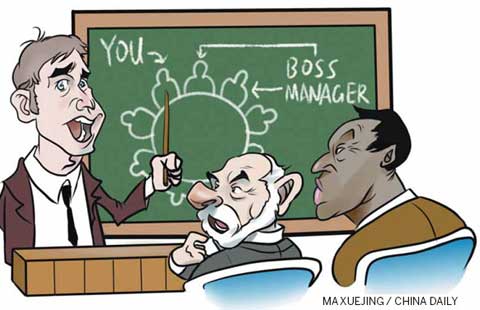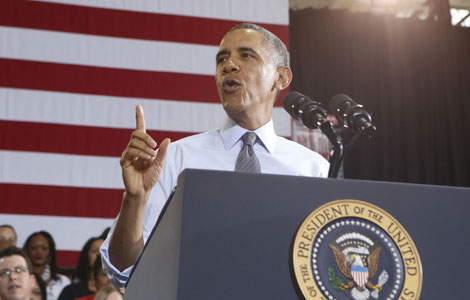US experts divided over China's local debts
Updated: 2014-01-31 10:21
By CHEN WEIHUA in Washington (China Daily USA)
|
||||||||
While US national debt in excess of $17 trillion has been an acute concern for their country, American experts have expressed both optimism and pessimism at China's growing local government debt, which has been a hot topic in the news media lately.
China's National Audit Office reported in December that China's local government debts had grown to 17.9 trillion yuan (about $3 trillion) by the end of June 2013, up about 70 percent from the 10.7 billion (about $1.8 trillion) at the end of 2010.
Nicholas Lardy, a senior fellow at the Peterson Institute for International Economics, is among the optimists.
He said although there are a lot of murky things about local government debt and uncertainties, people should pay less attention to the magnitude of the debt and more to its sustainability.
To Lardy, the bulk of the investment, which has been on municipal construction, such as transportation, housing and water, and some on science and environmental protection, is a good thing.
"I think the great bulk of expenditure looks like it will have high economic return. China needs more infrastructures," he said, while admitting that some investment has been used in white elephant projects.
The expert on the Chinese economy said the problem is that financial returns are extremely low and will not be sufficient enough to pay off the debts. But he said government should subsidize projects such as subway systems, which are a public good and benefit everybody.
"The fact that the subway system does not have the means to repay does not mean it's a mistake," he said.
Lardy does not exclude the possibility that he may modify his relatively optimistic view if he has more details to understand where the investment has gone. "But for the moment, I am relatively optimistic," he said.
Yukon Huang, a senior associate in the Asia program of Carnegie Endowment for International Peace, said the decline of investment efficiency is due to the fact that there is a surge of investment in interior part of China, when the central government seeks to promote more equitable development of income between the coast and interior.
"This is very much a regional issue rather than for the country as a whole," he said.
Huang, a World Bank country director for China from 1997 to 2004, believes the problem of mounting local government debt is caused by the small budgets in local governments while tax revenues mostly go to the central government. As a result, local governments create financial arms to raise money, using land as collateral.
Derek Scissors, a resident scholar at the American Enterprise Institute, is much less optimistic than Lardy.
He questioned whether those government numbers can be trusted when statistical bureaus always fall behind financial institutions. The debt number released is also based on a narrow definition.
He said when the numbers in China are wrong, it always means China is in worse shape than it represents.
"It's not just China. But finance moves faster than regulations do and faster than statistical bureaus do. You regulate one type of product, they create a new type of product that you aren't counting," he said.
Scissors believes that the problem is the mounting corporate debt. "I agree that the local government debt is not that dangerous. The corporate debt is dangerous," he said.
But he said an acute crisis is not likely because there are no counter parties. The borrowers and lenders are often related, or very related parties, sometimes owned by the same people, referring to the ownership by the government in the so-called transactions.
He described local government debt as China's "natural economic problem", something the Chinese government wants to address but in a slow fashion. "The more slowly they do, the more they are accumulating debts of all kinds," he said.
Lardy reminded people that unlike the US, China does not have a federal system and the central government will assume the responsibility to repay some of the debt.
In Lardy's view, China's local and central government debt ratio to GDP at 54 percent does not make China an outlier. "It's way below India's 71 percent and almost identical with Brazil and Turkey," he said.
He also pointed to the huge assets of State-owned enterprises, which are more than twice as large as liabilities.
Still, Lardy warned that the pace of growth of China's local government debt should slow down. "But the probability that this is going to create a financial crisis is low," he said.
Huang, of the Carnegie Endowment, said the policies rolled out after the Third Plenum of the 18th Central Committee of the Communist Party of China are potentially transformative if they are actually implemented.
"It will change the nature of the Chinese economy for the coming decade and the next," he said, referring to the announcement to give a big say to the market and conduct financial reform that has delayed for years.
Most Viewed
Editor's Picks

|

|

|

|

|

|
Today's Top News
Xi extends Lunar New Year greetings
Ambassador nominee vows to expand China ties
HK slaps sanctions on Manila
More Chinese set to travel overseas
Lenovo makes move on Motorola
China-themed malls a new trend in the Bay area
Replace dollar with super currency
Japan should learn from Germany
US Weekly

|

|














